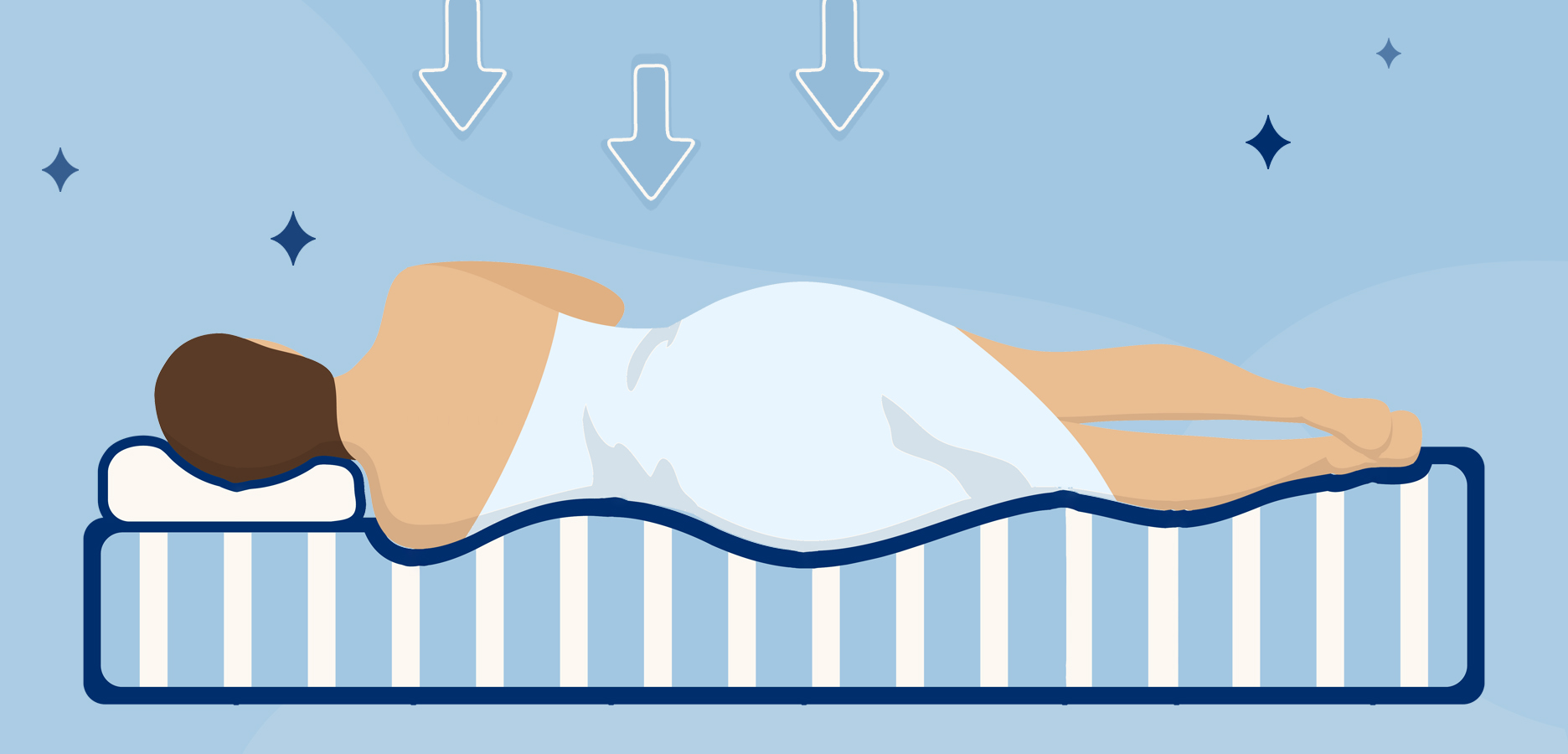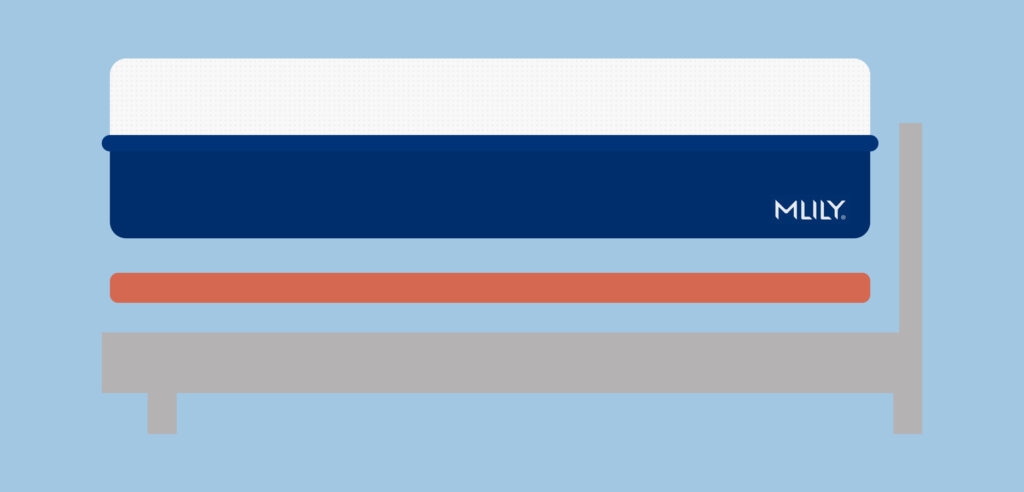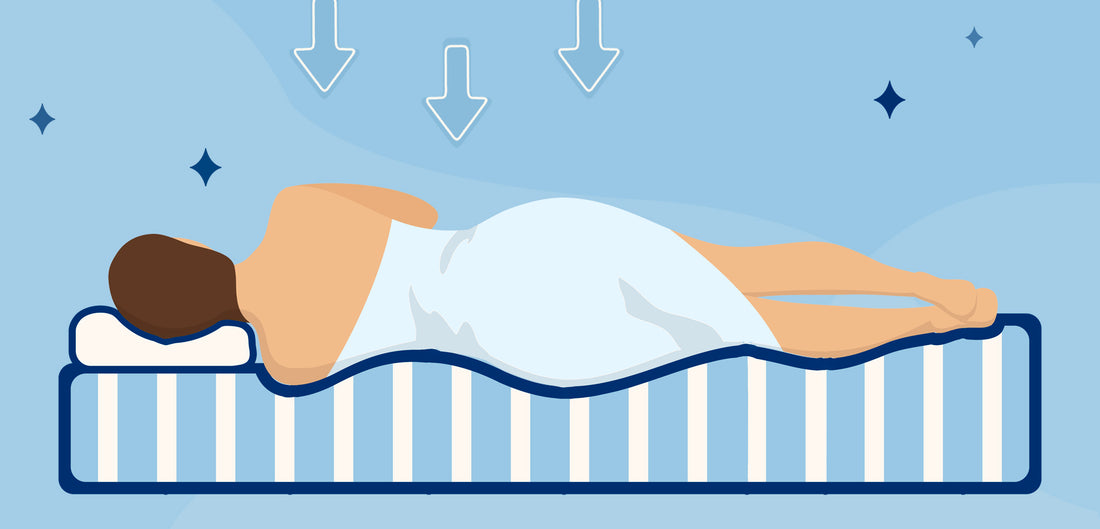
If your mattress is slightly or even moderately sagging, there are lots of ways to manage the problem. For instance, a bunkie board or a mattress topper can help. However, if your mattress is severely sagging, you may have to take more drastic measures.
Why Do Mattresses Sag?
Age will eventually cause all mattresses to sag, but several factors can decide how long a mattress lasts.
Construction is one such factor, as some mattresses last longer than others. For example, innerspring mattresses will sag far sooner than memory foam mattresses.
Maintenance is another major factor that impacts mattress sagging. Well-maintained mattresses won’t sag as fast as poorly-maintained ones.
Causes of Mattress Sagging

Mattresses can suffer premature sagging due to improper maintenance and use. For instance, children jumping on the bed can lead to premature sagging.
Failure to flip or rotate your mattress can create a specific sagging area. Failure to place your mattress on the appropriate support can also cause it to sag or develop indentions before its time.
Impact of Mattress Sagging on Sleep Quality
When mattresses start to sag, this can cause many issues that interfere with a good night's sleep. Back pain is the most common problem caused by a sagging mattress. Neck and shoulder pain are common as well.
Saggy mattresses can also exacerbate certain sleep disorders like sleep apnea. They also reduce the depth of your sleep by making you generally uncomfortable.
How to Fix a Sagging Mattress and Mattress Indentations
Temporary Fixes for a Sagging Mattress
Using Mattress Toppers
Using a mattress topper can help even out the sleep surface of your saggy mattress. If your mattress is sagging in a particular area, like the middle, you can also place flat pillows under your firm topper to even things out.
Flipping and Rotating the Mattress
We suggest in our care card to rotate every 90 days. Some mattresses are designed with a specific top and bottom. If this is the case, you cannot flip the mattress, but rotate it to prevent sagging.
Adjusting the Mattress Foundation
Your mattress support could be to blame for sagging. If you put your mattress on a support that cannot bear its weight (like putting a hybrid mattress on box springs), your bed will sag. Try switching to a sturdier support to fix your sagging mattress.
Add Extra Support

Extra support under your mattress can help shore up the support you feel on the sleep surface. Try a bunkie board between your mattress and mattress foundation for a quick fix to sagging.
Pillows
Pillows can provide a temporary solution if your mattress is sagging in specific areas. Place a pillow of the appropriate size and thickness in the mattress indentation, underneath your mattress protector and sheets. For a more even feel, layer a memory foam mattress topper above the pillow but under the protector.
Additional Support Structures
You can place extra support structures, such as plywood or two-by-four boards, underneath the saggy areas of your mattress to help push them up and in line with the rest of the sleep surface.
Permanent Solutions for a Sagging Mattress
Replacing the Mattress
Sometimes, the only solution to a saggy mattress is to buy a new mattress. Temporary fixes cannot help an old mattress with severe sagging, so you’ll want to replace your mattress if your current one has aged out of usefulness.
Investing in a Supportive Bed Frame
If you’re experiencing sagging issues but know you don’t need a new mattress, your bed frame may be to blame. Box springs are not supportive enough for most new mattress types, so you’ll want to swap them out for a platform bed or a mattress foundation. These supports have wooden or metal slats instead of internal springs, making them much sturdier.
Considering Different Types of Mattresses
Certain types of mattresses sag earlier than others. Innerspring mattresses sag the fastest. You’ll have to replace an innerspring mattress every ten years – if not sooner.
Hybrids also sag faster than foam mattresses, thanks to their internal coils, but they last much longer than innerspring. For mattresses that can resist sagging for the long haul, stick to memory foam and natural latex.
A Fantastic Sag-Resistant Mattress: The MLILY Harmony Plus
Among the most sag-resistant mattresses we offer in the MLILY lineup is the Harmony Plus. One of our memory foam offerings, it provides a medium-firm feel that is versatile enough to accommodate your sleep position while still resisting sagging.
The Harmony Plus starts off with an ultra-soft yet ultra-strong cover that provides breathability and durability. This cover sits on top of a layer of our proprietary Gel AeroFusionTM memory foam that cools you by drawing heat away from your body.
This cooling memory foam is supported by a layer of performance memory foam that offers lots of lift and contouring. It also helps prevent sagging in the sleep surface, as does the ultra-supportive medium-firm feel.
How to Prevent Your Mattress from Sagging
Maintain Proper Mattress Care
To properly maintain your mattress:
- Flip and/or rotate your mattress every six months.
- Keep it clean and dry.
- Don’t lay it on inappropriate supports.
- Use it only as intended.
- Keep it flat (don’t fold or tilt it on its side).
Use a Mattress Protector

Using a mattress protector ensures your mattress stays clean and dry, but a tight mattress protector can also provide support to the sides of the mattress.
Rotate and Flip Regularly
If you fail to change the areas where your mattress is bearing weight on a regular basis, it can create soft spots and indentions. This is why rotating and flipping are so important, as they allow you to place your weight on different areas of the mattress.
Avoid Jumping on the Bed
Jumping on the bed can damage the internal support structure of the mattress, causing it to sag prematurely. So if you have kids or pets who love to jump on the bed, watch out!
When to Replace Your Mattress
Signs of a Worn-Out Mattress
Signs of a worn-out mattress include but are not limited to:
- Sagging
- Soft spots
- Body impressions
- Noisy springs (innerspring mattresses especially)
- Lumpiness (especially in a pillow top mattress)
- Unpleasant smells
- Visible damage
If you start seeing signs like these, it’s time to purchase a new mattress.
How Often to Replace Your Mattress
As wonderful as it would be to be able to buy a mattress that lasts forever, you should be replacing your mattress every decade or two. The best mattresses for longevity are solid foam. This is because foam takes longer than coils to break down.
If you get coils, you will be replacing your mattress every 10 to 15 years. Mattresses made of foam, especially dense foam, can last longer.
Benefits of a New Mattress
There are tons of benefits to a new mattress, especially if your old one has been sagging. Benefits include:
- Improved spinal alignment
- Back pain alleviation
- Superior temperature regulation
- Increased responsiveness
- Having an easier time getting in and out of bed
- Reduced allergy symptoms
- Getting a better night’s sleep
Conclusion
These tips and tricks for making your mattress stop sagging can improve the quality of your sleep if your mattress is not sagging too severely. If, however, it is sagging badly or suffering other signs of aging, it may be time to invest in a high-quality mattress replacement.
FAQs
Can a sagging mattress cause back pain?
Back pain is one of the worst effects of sagging mattresses, and one of the most common. This is because sagging mattresses throw your spine out of alignment when you sleep instead of supporting natural alignment.
How often should I rotate my mattress to prevent sagging?
You should rotate your mattress every 90 days to ensure each area of the mattress is bearing the same amount of weight over time. This can help prevent premature sagging.
Will a mattress topper help with sagging?
A topper cannot help reduce sagging in the mattress, but it can help cover it up temporarily. Firm toppers can help ensure you don’t feel the sagging, but they will not increase support in the mattress.
Why is my mattress sagging in the middle?
Most mattresses sag in the middle because this is where their support is the weakest. Support from the sides is strongest around the perimeter, leaving the middle of the mattress more vulnerable to sagging.
What type of mattress is least likely to sag?
Mattress warranties are often a good indicator of how long your mattress will last. But, in general, sticking to mattresses made of solid foam will allow you to keep your existing mattress longer.
